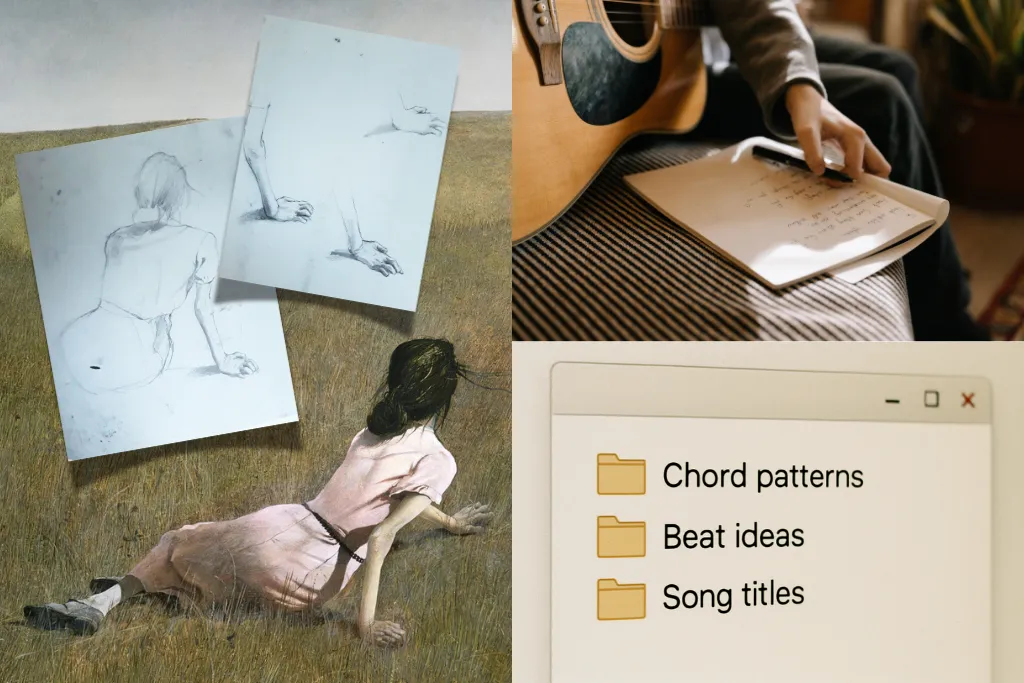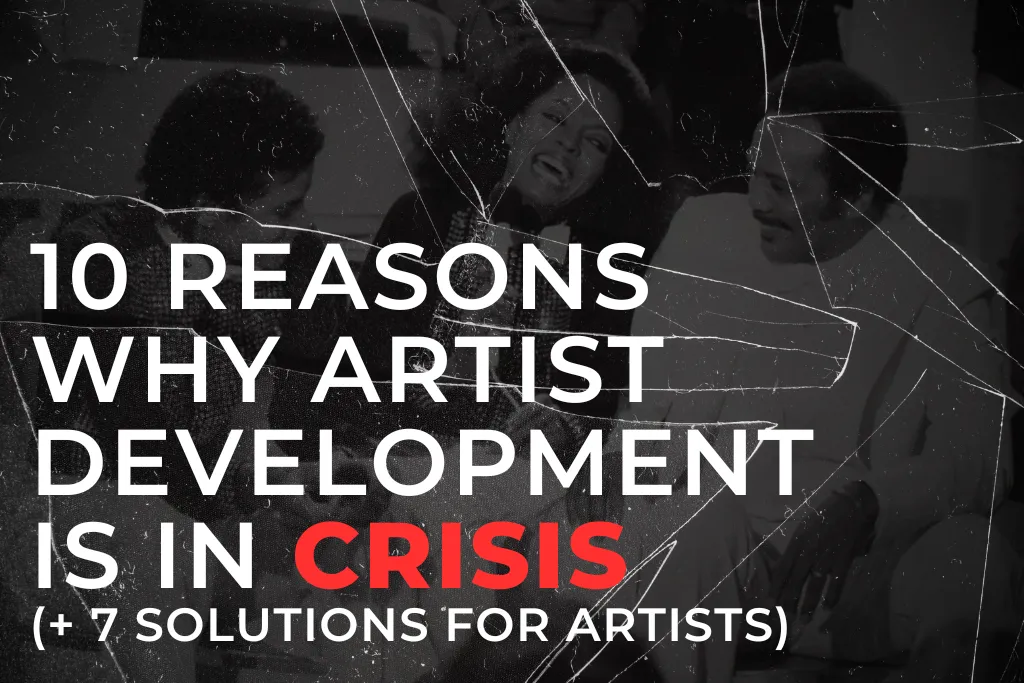Question: Do amazing painters and artists simply jump in on a blank canvas to create their masterpiece, or do they slowly evolve their greatest works by way of “studies” and “sketches”? On that note, I’m excited to jump into a new songwriting exercise and observation I’ve come up with—one that you can glean from the greatest artists in completely different realms.
In short, this is often the way most famous painters and artists of the world create their masterpieces.
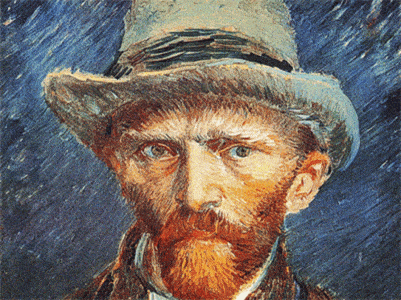
The masters of art
Yes, this article is about masterpieces, but more so, it’s about “studies” and “sketches” and how you can apply these ideas to your own musical work and songwriting methods.
You’ve all heard about painters and drawers who keep sketchbooks, right? Maybe they even use different mediums (e.g., pencil, watercolors, inks, etc.) to keep things interesting and add variety to their art and craft.
You see, “studies” and “sketches” are the stepping stones to creating masterpieces.
And sure, I get it if your knee-jerk reaction to the word “studies” is, “Gahh! Who wants to study?” Well, it’s not that kind of study, so stick with me here.
I came up with this realization when I was at the Farnsworth Art Museum in Rockland, Maine. If you’ve never been to Maine, I “kinda-sorta” highly recommend it. Rockland is a tad lower in hipster value than, say, Portland or Camden, Maine. But essentially, the “cool” and trendy part of Rockland is a singular main street about a half mile long.
On this street is one of my favorite museums, primarily because it’s a museum solely dedicated to the Wyeth family (and extended family of painters): Howard Pyle, who taught N. C. Wyeth, who taught his son, Andrew Wyeth, who taught his son, Jamie Wyeth. The four of them are incredible, each with his own sense of mastery (and associated weirdness). And as you guessed, the artwork is very New England driven.

Farnsworth Art Museum
But back to my point. I was at the museum, and they had a special presentation of Andrew Wyeth’s Christina’s World. (This is by far the most famous painting by Andrew, and I think you probably know it.)
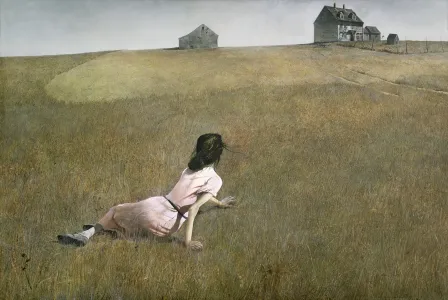
“Christina’s World”
Part of the exhibition showcased the “studies” that took place before the masterpiece was created by Wyeth. In fact, there were a number of final paintings and the associated sketches and studies that accompanied them.
By studies, I mean Andrew Wyeth didn’t just grab a blank canvas and decide to create this masterpiece in one shot. Oh no, no, no!
He started with and perfected “studies” and “sketches.” In fact, this is likely how a lot of amazing painters work.
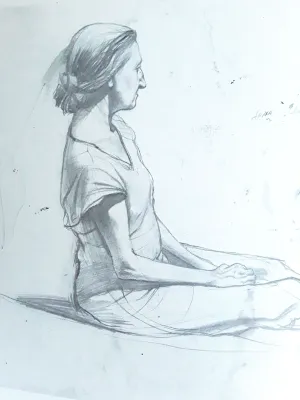
The “sketches” behind “Christina’s World”
For example, working with and perfecting the textures of the wheat field, the windows of the house, the positioning and sketches of Christina lying in the field. I could go on and on. But it was very clear to me then that Andrew Wyeth, as a master painter, didn’t just make this one piece without doing several individual studies to discover and explore where the magic was.
Then, when he was ready, he was able to assemble all of these “experiments” and perfected studies for his grand masterpiece.
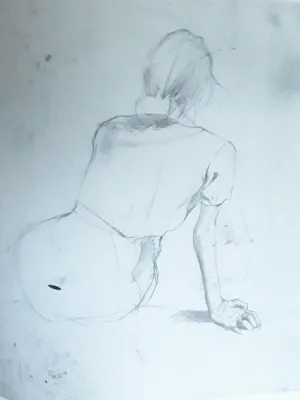
The “sketches” behind “Christina’s World”
Does this sound potentially familiar? Are you getting any ideas here?
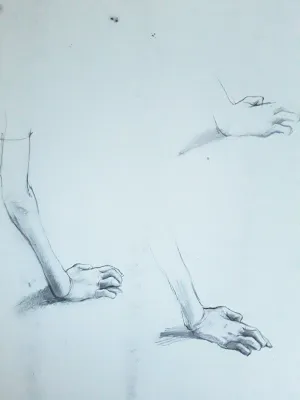
The “sketches” behind “Christina’s World”
The point I’m making is that part of your curriculum in creating great music and art should be “studies” and “sketches.” That’s right—get out your metaphorical “sketchbook,” whether these are voice memos, folders and templates in your DAW, actual bounces and “sketches” of potential choruses, verses, pre-choruses, etc. Try approaching these like a songwriting exercise—an intentional practice to explore and refine your ideas without the pressure of creating a finished piece right away.
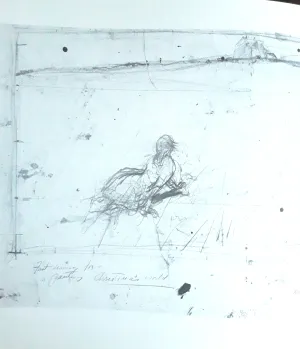
The “sketches” behind “Christina’s World”
How could this look in practice? Let me give you some ideas and things I’m doing as well.
For example:
1. Taking a day to focus on creating riffs and second melodies. (And if you’re not sure what a “second melody” / “riff” is, it’s essential! Check out the full article here.)
2. Setting up liberating constraints. For example, conducting a songwriting exercise or study where you’re writing a song with just two chords.
3. A study of writing melodies that have large or extreme intervals (interval writing).
4. Writing in a mode (i.e., Dorian or Phrygian mode). (Check out modal writing online—it’s rad and will instantly give your song a different flavor.) Hint: “Eleanor Rigby” by The Beatles was written in Dorian mode.
“Eleanor Rigby”
5. Conducting a study whereby you’re piecing together and “splice mining” amazing beats and setting up templates for you to later work on.
6. Write a verse with one note and have the harmony change underneath to make it interesting.
7. Write a song with no chords.
8. Pick up a new instrument (or synth) and get inspired by its new sonics (or patches).
9. Write a song or a section at an insanely fast tempo. I pulled that one from Brian Eno’s own list of ideas. Eno is famously said to have gotten U2 to double the tempo of “Beautiful Day.”
“Beautiful Day”
10. Write a “call and response” song. Prince was a master of this, especially by using instrumental riffs as the “response” to his vocal “call.”
“Let’s Go Crazy”
Those are just a few ideas.
In fact, I just gave a study example to the writers I work with on a call today. How about:
11. Write “studies” aka songs / tracks that instantly jump off the page in the first four measures. Just write four to eight measures for this study of songs, beats, riffs, sounds, etc., that just jump off the page and grab you! This kind of focused songwriting exercise can help you zero in on what makes a track immediately compelling.
At the end of the day, the idea here is simple.
Instead of presuming that you’re going to write your masterpiece in one shot, how about writing smaller sections and “studies”? This approach completely changes your songwriting process—what I like to call “stockpiling your inspiration.” And I wrote a whole article on this concept here if you want to learn more.
Let’s dive in further on how this could work. Let’s say you already have your concept and an outline for your next masterpiece or next song you’re supremely excited to write! Wow. You’re excited!
But you also know this is going to be a potential mountain to climb or a huge undertaking. It might be daunting! But here’s the hack: Can you break it down into sections and elements where you can create individual studies around the song?
Chunk this down into bite-sized pieces and just work on those “studies” and “sketches” individually—meaning ideas and segments that you can further assemble and build up to your finished great work.
Let me give a further example of how this could work.
Take a masterpiece like “Bohemian Rhapsody” by Queen. Turns out it took Freddie Mercury seven or eight years to write this song. That’s right—I said Y E A R S. And it took three full weeks to record, with apparently 180 overdubs. That’s not to say you have to do the same, but success leaves clues!
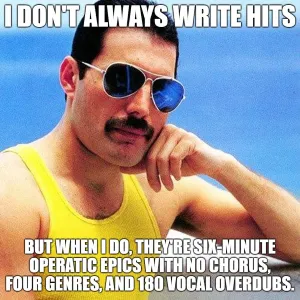
“I don’t always write hits…”
So, let me ask you…do you think Freddie Mercury and Brian May just started on the first note and wrote it that way from beginning to end? Or perhaps—was the opening piano riff perhaps tucked away as an idea on a sketch of music paper five years earlier?
Maybe “Bohemian Rhapsody” as a song title alone was written down three years or three months previous to writing the piece? (Note: “Bohemian Rhapsody” as a word phrase is never sung during the song.)
Was the epic operetta formulated and refined completely on its own, perhaps even before Freddie considered where it would fit in a song?
What about that blazing guitar riff from Brian May? You know the one—the one that comes right after “for me….for MEEE!…for MEEEEEEEEEEE!!!”? Did Brian May have that written down somewhere in one of his “sketchbooks,” saved for just the right opportunity?
I could go on and on here, but you see what I’m saying.
When it comes to “Bohemian Rhapsody” or other classics, it could likely be that these specialized sections of a song, pieces of a lyric, guitar riffs, passages, chord progressions, etc., probably existed in various formats and in various stages of development…for years! Maybe they weren’t even intended to be used in this way but perhaps existed separately as amazing sections, ideas, elements, textures, riffs, harmonies, melodies, lyrics, etc.—each one potentially born out of a songwriting exercise that wasn’t originally tied to a finished song.
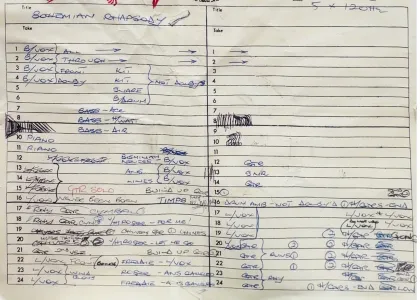
“Bohemian Rhapsody” track sheet
The genius was not just these individual pieces and sections (which could have been “studies” on their own) but the collage and intertwining of “level 10” pieces of songcraft that showcase perhaps the pinnacle of masterpiece songwriting.
“Bohemian Rhapsody”
The other beautiful thing about writing and focusing on individual studies is that it allows you not just to stockpile your inspiration but also to provide yourself objectivity. That’s right. You might have just a silo of “verse” ideas or “hook” ideas or “hot beats” or “favorite riffs” and, for sure, a song title / song concept diary.
These can all be elaborated upon and set away in your “songwriting pantry” (if that metaphor makes sense). Then, when it’s time to write, you get the opportunity to take things off the shelf and listen to them with a fresh view, fresh ears, and a fresh perspective!
In fact, you just might be able to assemble some dots and see how idea #15 from your melody folder, riff idea #29, that song concept you wrote down two years ago, and that new genre mashup you had an inspiration to write now have all the pieces pre-assembled—each originally born from a songwriting exercise or creative sketch that’s finally found its place.
Yes! You’ve already done the work as studies! Now you have the luxury to perhaps assemble them (what can also be affectionately called “Frankensteined”).
“It’s alive!”
And here’s another idea why having your proverbial sketchbook of studies and drawings is vitally important.
If you have these ideas, when you’re ready to start your next writing session (with yourself or someone else), all those great starts or “A” level seed ideas that you’ve stashed away—well, they’re just literally begging and waiting for you and your co-writer to pump life into them.
This is the “bible” for songwriting success: Start with “A” level / amazing “seed” ideas for “A” level songs to be created. Grab these from your sketches and studies—or even from a focused songwriting exercise—as a ground zero basis point for your new hit.
Make no mistake—the timeless masterpiece artists (both in painting and music) have it figured out—and come correct.
Take a page from their history, and let’s see how you do.
Panoramio user MementoMori, CC BY 3.0, via Wikimedia Commons
海獺, CC BY-SA 4.0, via Wikimedia Commons
